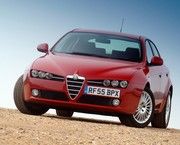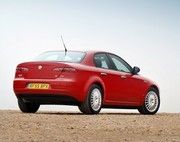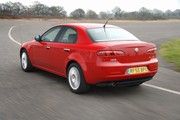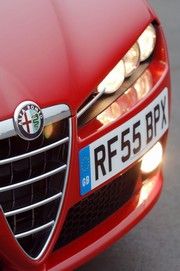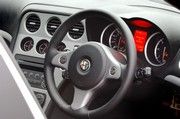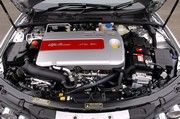Alfa Romeo 159 arrives
All-new Alfa looks the business
The all-new, Alfa 159, which replaces the 156, goes on sale in the UK on Saturday 25 February.
Designed by Giorgetto Giugiaro in collaboration with Alfa Romeo Centro Stile at Arese, Milan, the 159 is built on a new platform, said to have a best-in-class torsional rigidity of over 180,000 daNm/rad.
Safety
Alfa makes a big deal about the car's safety features. It's recently been awarded a five-star safety rating from Euro NCAP, and includes an all-new floorpan that incorporates high performance materials, multi-ply sheet metal, and laser welding. The construction of the bodyshell also uses boxed elements that are connected rigidly both transversely and vertically; three ‘load lines’ in the front, longitudinal beams that run the entire length of the car, built-in deformable structures, and a large number of spot welds around structural nodes.
The 159 also boasts eight airbags, seven of which are standard equipment on UK cars, including special bags to protect the knees, and sidebags that extend all along the complete window area. In addition, there are innovative restraint systems (pre-tensioners and load limiters on the seatbelts), and front seats with an anti-whiplash system that automatically brings the head restraint closer to the occupant’s neck in the event of a rear impact.
The central pillar has three reinforcement levels to protect passengers from side-on collisions, whilst the high-strength steel floor has been designed with three load lines to prevent it from folding even in high speed head-on collisions.
Versions and engines
Nine versions of the new Alfa 159, priced from £19,995 to £28,195 on-the-road, will be available, seven of which will be available at launch, with a choice of five powerplants. Three new direct injection petrol engines – 1.9-litre 160bhp and 2.2-litre 185bhp 4-cylinder units, and a 3.2-litre 260bhp V6 available from March 2006 – combine the JTS (Jet Thrust Stoichiometric) direct injection with continuously variable valve timing, inlet and exhaust.
With specific power outputs of between 81 and 85bhp/litre, and almost 90 per cent of maximum torque available at 2,000rpm, all three new JTS units are said to offer significant fuel savings and comply with stringent Euro 4 exhaust emission regulations.
The two diesel engine options complete the range. They include a 1.9-litre, 16 valve 150bhp 4-cylinder unit, and a 2.4-litre 20 valve 200bhp 5-cylinder powerplant, both of which feature the company’s JTD MultiJet common rail direct injection systems.
Both units also feature variable geometry turbocharging, and incorporate a ‘for life’, maintenance-free particulate trap (DPF) in anticipation of Euro 5 emissions regulations. Alfa Romeo’s twin overhead camshaft 1.9 JTDM 16v unit now combines a power delivery of 150bhp with 236lb.ft of torque – a figure comparable to that generated by the company’s four overhead camshaft, 24 valve, all-aluminium 3.2-litre JTS V6.
Engine technology
The 3.2 JTS engine in the new Alfa 159 operates with a lean burn system up to about 1500rpm, making significant fuel savings. Above this engine speed, however, it burns a stoichiometric air-fuel mixture – i.e. with a conventional 14.7:1 ratio between the two components – thus guaranteeing performance superior to that achievable by a conventional, indirect injection unit.
Primarily, this is because fuel injected directly into the combustion chamber – instead of the intake ports – cools intake air, thus increasing the engine’s volumetric efficiency. As the temperature drops, so the gases increase in density and the volume therefore decreases, allowing more air into the combustion chamber. Cooling the chamber also reduces the risk of engine knock, allowing for an increase in compression ratio – in this case to 11.25:1 – and a commensurate improvement in engine efficiency.
Allied to JTS technology, the light aluminium alloy cylinder heads of the new 3.2-litre V6 also features ‘Twin Phaser’ continuously variable valve timing – for both intake and exhaust – already adopted on 4-cylinder JTS Alfa Romeo engines. Via two camshafts per cylinder bank, variable valve timing allows the phase angle of both inlet and exhaust cams to be varied by up to 50 degrees, optimising the volumetric efficiency of the engine at all engine speeds while reducing fuel consumption and emissions under lighter throttle settings.
The new camshaft drive system features maintenance-free chain drive with automatic hydraulic tensioners, while the valves are controlled by a low friction roller finger system with hydraulic uptake of tappet play.
This new V6 combines power and torque peaks of 260bhp at 6,200rpm and 237lb-ft at 4,500rpm respectively with a linear power delivery from low speeds. Some 90 per cent of peak torque is available from 1,800rpm and maintained up to 6,250rpm.
Transmission, brakes and steering
All five engines are mated to six-speed manual gearboxes, with automatic transmissions becoming available on 1.9 and 2.4 JTDM and 3.2 V6 JTS versions later in 2006.
The 3.2 JTS-engined versions come with Alfa Romeo’s Q4 permanent four-wheel drive system, which employs three differentials, with a self-locking Torsen C unit at the centre of the system which divides drive torque by a ratio of 57 per cent to the rear wheels and 43 per cent to the front in normal driving conditions. Torque is split between front and rear axles and constantly modulated by the central Torsen differential on the basis of available grip, with a bias towards the rear axle.
The suspension of the new Alfa 159 combines revisions to the high, double wishbone set-up of the outgoing Alfa 156 with a new multilink rear configuration. Alfa reckoned the new system is designed to promote smooth, accurate steering responses, exceptional stability and controllability – even when close to adhesion limits – with body control allied to remarkable comfort over all road surface conditions. Hmm...
Brakes comprise 305mm ventilated front discs, and 278mm solid discs at the rear. Versions powered by the 3.2 JTS petrol and 2.4 JTDM turbodiesel engines feature larger, 330mm ventilated discs and Brembo four piston monobloc aluminium callipers at the front, with 292mm ventilated discs at the rear.
The speed-sensitive power assisted steering takes 2.3 turns lock-to-lock.
Electronics
The new car comes with electronic braking, traction control and stability systems fitted as standard. ABS anti-lock braking is combined with Electronic Brakeforce Distribution over all four wheels, and a Vehicle Dynamic Control unit enhances cornering stability. VDC is further augmented by Anti-Schlupf Regelung (ASR) to limit wheelspin during acceleration.
Motor Schleppmoment Regelung (MSR) modulates braking torque when changing down through the gears, and a unique Hill Holder function facilitates smooth hill starts.
Features
The car has a wheelbase 105mm longer than its predecessor, improving both front and rear passenger legroom. Despite being lower than the 156, the 159 offers improved front and rear door access and an increase in interior headroom, particularly in the rear, according to the carmaker.
Standard equipment includes seven airbags, automatic dual zone climate control, cruise control, ‘Follow Me Home’ headlamps, heated, folding electric door mirrors, a multi-function display and trip computer, fog lights, 16-inch or 17-inch spoked alloy wheels, and an RDS 8-speaker stereo radio with CD player.
Optional equipment includes Tri Zone climate control, xenon headlamps, satellite navigation (either independent or incorporated within bCONNECT), electrically adjustable front seats, a Bose sound system, Bluetooth mobile phone connectivity and 18-inch alloy wheels.
The bCONNECT on-line telematics system connects the driver to an range of services via a live phone link to an English-speaking operator, as well as including a satnav system. The system combines voice commands with a 6.5-inch colour display screen, and includes a dual band GSM phone with Internet access, satnav and an MP3-compatible CD sound system.
Styling
Continuing Alfa's recent design trends, the Villa d’Este style Alfa shield with horizontal chrome bars dominates the front of the 159. The grille extends full-height from the bonnet’s leading edge to the lower lip of a deep air dam, bisecting both an upper air intake housing three lamp headlight clusters, and a lower air intake, with circular fog lamps at its extremities.
The top of the shield generates bonnet coachwork lines which flow into the steeply raked A pillars. An Alfa styling cue, the number plate is offset to the left.
Further back, the strongly raked rear window finishes well behind the wheel arch above a rear end featuring slim, horizontal light clusters which bisect the boot shut line. Full width colour coded bumpers, and a boot lid spoiler complete the rear.
The new Alfa 159 will be available in a choice of nine colours at launch, including both solid and metallic black, three shades of grey – Stromboli, Vesuvio and Titanio – Alfa Silver, Alfa Red, Oltremare Blue and Rubino Red. Three further colours will be added to the range later.
Interior
The interior is driver-focused, including a height adjustable seat allied to a rake and reach adjustable, and a leather clad steering wheel. The instrument binnacle houses large, deeply hooded speedometer and rev counter dials, backlit in white. A multi-lingual, multi-function display gives access to a wide range of functions as well as the trip computer. Subsidiary gauges comprise fuel and engine temperature, turbo boost (diesel) and oil temperature (petrol).
The centre console includes a new, electronic key-activated engine start button, dual or tri-zone climate control and a stereo radio/CD player. The stereo features a power output of 4x30 watts and eight speakers.
An optional 60:40 split/folding rear seat with integral armrest allows for the rapid expansion of the 405-litre luggage compartment into a robust, practical load platform. Storage consists of up to 14 bins and compartments scattered around the interior.
Turismo trim level models are upholstered in Alfatex, a soft, durable, easy to clean fabric patented by Alfa Romeo, available in black, grey or beige with a range of complementary dashboard colours. All Lusso models will come with a choice of black, tan, red, blue or beige leather upholstery fitted as standard.
Gassing Station | Alfa Romeo, Fiat & Lancia | Top of Page | What's New | My Stuff

